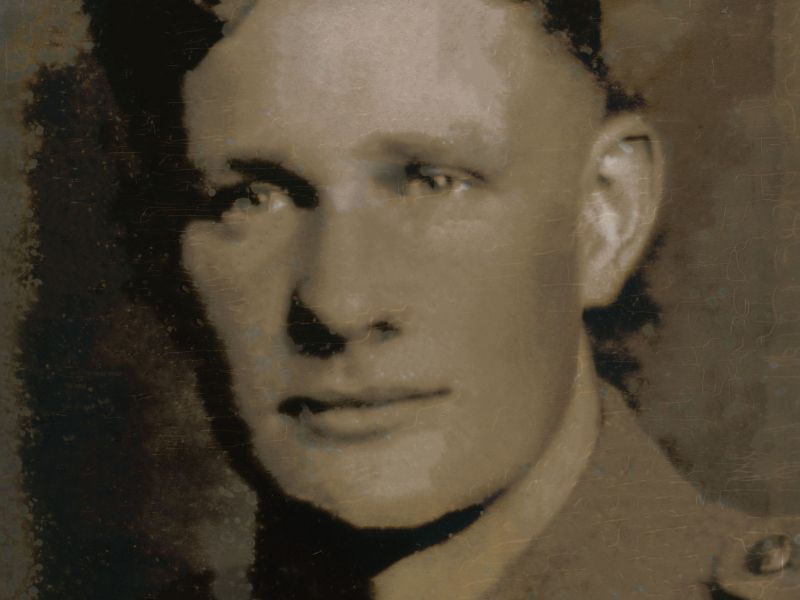Joseph Allan Hamilton
Joe was born on the 29th of January 1919 in Albury, New South Wales. He was one of six children to Allan Leach and Mary May (née McKenzie) Hamilton of Corryong, Victoria. When Joe was only three years old, his brother Charles was accidentally killed.
Joe enlisted at the age of 21 at Caulfield on the 24th of June 1940. He was allocated the Army Number VX29599 and given the rank of Private.
Initially he was placed on strength at the Recruit Reception Depot at Caulfield racecourse near Melbourne. Five days later on the 29th of June 1940, he was transferred to No. 8 Training Depot at Albury in New South Wales. That same day he was promoted to acting Corporal with a further promotion to acting Sergeant on the 8th of August. On the 20th of that month he was posted to the 2/23rd Battalion (Albury’s Own) but soon had to revert back to Private due to there being too many Sergeants in the battalion. It wasn’t long before his skills were once again recognised and he was promoted back to acting Corporal by the 14th of September.
A week later the battalion moved from the Albury racecourse to their newly constructed training facility at Bonegilla across the Murray river in Victoria. In late October Joe found himself admitted to hospital suffering from the mumps. Two weeks after being discharged from hospital and with their training complete, Joe and the rest of the 2/23rd travelled by train to the Port of Melbourne and embarked on HMT Strathmore. A little over a month later, on the 17th of December, they disembarked at El Kantara at the northern end of the Suez Canal. Trucks then took the battalion to their final destination, the camp at Dirma in Palestine.
In mid December Joe attended a course as his rank of corporal had been confirmed. It wasn’t long before he was promoted again, this time to the rank of Lance Sergeant. January and February were spent in vigorous training in order to reach a high standard of efficiency and physical fitness. On the 13th of March the battalion began its journey westward into the Western Desert field of operations. Early 1941 was a positive time for the Allied forces as they captured many coastal towns including Bardia, Tobruk and as far west as Benghazi. Thousands of Italians had been taken as prisoners of war. In early March the highly trained and well equipped Afrika Korps, commanded by the highly capable General Erwin Rommel. The Germans advanced east with lightning speed, catching the Allied forces off guard. A hasty, and highly confused, withdrawal began which became known as the “Benghazi Handicap”. The 2/23rd found itself at Tobruk which eventually became besieged by the German and Italian forces.
At 1800 hours on the 15th of April brigade headquarters advised the battalions that an enemy attack was developing. The 2/23rd was ordered to mount a counter-attack. After covering a distance of 1500 yards A Company was heavily shelled but the line did not waver and they pressed on. The only casualty was Joe, wounded in the left leg. He was evacuated to the 4th Australian General Hospital which was inside the Tobruk salient. After nearly two weeks he was transferred to the 63rd British General Hospital at Helmiah near Cairo and then finally to the 2nd Australian General Hospital at El Kantara near the Suez Canal. Joe would not return to his battalion until the 15th of August 1941, which at that stage was being relieved from Tobruk and returning to Palestine.
On the 28th of September his promotion to full Sergeant came through. He spent nearly six weeks as a patient at the 7th Australian General Hospital suffering from cholangitis, a bacterial infection of the bile duct. On the last day of 1941, Joe returned to the 2/23rd which was in Syria, resting and undertaking garrison duties.
By July 1942 German and Italian had reached El Alamein in Egypt, only 100 kilometres from Alexandria. The 9th Division, which included the 2/23rd as part of its 26th Brigade, was relocated from Syria and sent to El Alamein. The Division’s orders for their first attack were issued on the 7th of July. The brigade advanced along the coast driving a wedge between the sea and the Afrika Korps positions, capturing a feature known as Tel El Eisa.
General Auckinleck, commander of the Allied Eighth Army in Egypt, planned further heavy strikes against the enemy to take place on the 21st and 22nd of July. The 2/23rd Battalion’s task was to capture and consolidate areas around the features called East Point 24 and Ring Contour 25.
Unlike Arthur Chitty, there is no mention of the part that Joe took in this attack. There is no mention in either the Battalion War Diary or “Mud and Blood”, the written account of the 2/23rd in the Second World War. His service record simply states that he was killed in action on the 22nd of July 1942 and was buried in the El Alamein War Cemetery in Egypt.
Joe is also remembered on the Australian War Memorial Roll of Honour, and the Corryong War Memorial. For his service, he was awarded the 1939-1945 Star, the Africa Star, the Defence Medal, the War Medal 1939-1945 and the Australian Service Medal 1939-1945.

 Stephen Learmonth
Stephen Learmonth